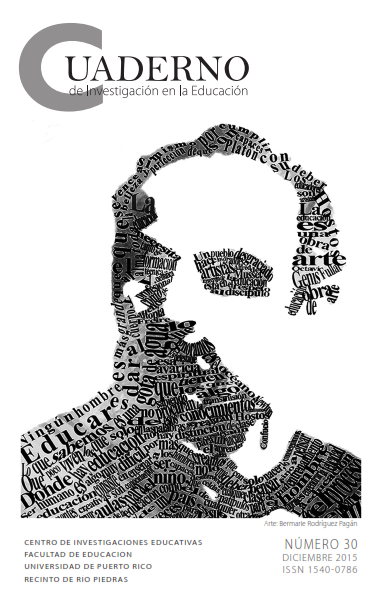Abstract
Ciencia Puerto Rico, a non-profit organization dedicated to promoting science, research and scientific education among Latinos, organized an educational symposium to provide college science majors the tools, opportunities and advice to pursue graduate degrees and succeed in the STEM disciplines. In this article we share our experiences and lessons learned, for others interested in developing large-scale events to recruit underrepresented minorities to STEM and in evaluating the effectiveness of these efforts.
Cómo citar:
González-Espada, W., Díaz-Muñoz, G., Feliú-Mójer, M., Flores-Otero, J., Fortis-Santiago, Y., Guerrero-Medina, G., López-Casillas, M., Colón-Ramos, D. A., & Fernández-Repollet, E. (2015). Assessing a Graduate School Science Recruitment Symposium. Cuaderno de Investigación en la Educación, 30, 55-70. Recuperado a partir de https://revistas.upr.edu/index.php/educacion/article/view/13245
References
Bogdan, R. C, & Biklen, S. R. (1998). Qualitative research in education. Needham Heights, MA: Allyn & Bacon.
Carpi, A., Ronan, D. M., Falconer, H. M., Boyd, H. H., & Lents, N. H. (2013).
Development and implementation of targeted STEM retention strategies at a Hispanic-serving institution. Journal of Hispanic Higher Education, 12(3), 280-299.
Chubin, D. E., May, G. S, & Babco, E. L. (2005). Diversifying the engineering workforce. Journal of Engineering Education, 94, 73–86.
Creswell, J. W. (2003). Qualitative inquiry and research design: Choosing among five traditions. Thousand Oaks, CA: Sage.
Crisp, G., Nora, A. & Taggart, A. (2009). Student characteristics, pre-college, college, and environmental factors as predictors of majoring in and earning a STEM degree: An analysis of students attending a Hispanic serving institution. American Educational Research Journal, 46(4), 924-942.
Denzin, N. K. & Lincoln, Y. S. (2005). The Sage handbook of qualitative research (3rd. ed.). Thousand Oaks, CA: Sage Publications.
Hassoun, S. M. N. (2001). Practices for recruiting and retaining graduate women students in computer science and engineering. Paper presented at the International Conference on Microelectronic Systems Education, June 17-18, Las Vegas, NV.
Hernández, P. R., Woodcock, A., Schultz, P. W., Estrada, M., & Chance, R. C. (2013). Sustaining optimal motivation: A longitudinal analysis of interventions to broaden participation of underrepresented students in STEM. Journal of Education Psychology, 105(1), 89-107.
Maddox, A. B., & Smith-Maddox, R. P. (1990). Developing graduate school awareness for engineering and science: A model. Journal of Negro Education, 59(3), 479-490.
Merriam, S. B. (1998). Qualitative resign and case study applications in education. San Francisco, CA: Jossey-Bass.
National Research Council. (2011). Expanding underrepresented minority participation: America‘s science and technology talent at the crossroads. Washington, D.C.: The National Academies Press.
National Science Foundation, Division of Science Resources Statistics, NSF/DSRS. (2011). Women, minorities, and persons with disabilities in science and engineering: 2011. Special Report NSF 11-309. Arlington, VA. Retrieved from http://www.nsf.gov/statistics/wmpd/
Palmer, R. T., Maramba, D., & Elon, D. (2011). A qualitative investigation of factors promoting the retention and persistence of students of color in STEM. Journal of Negro Education, 80(4), 491-504.
Peralta. C., Caspary, M., & Boothe, D. (2013). Success factors impacting Latina/o persistence in higher education leading to STEM opportunities. Cultural Studies in Science Education, 8(4), 905-918.
Saenz, V. B., & Ponjuan, L. (2009). The vanishing Latino male in higher education. Journal of Hispanic Higher Education, 8(1), 54-89.
United States Department of Labor (2015). Occupational Outlook Handbook: Jobs Outlook. Washington, DC. Bureau of Labor Statistics. Retrievedfrom http://www.bls.gov/ooh/life-physical-and-social-science/home.htm
The contents published in the Puerto Rico Journal of Education is freely distributed under open access practices, in accordance with the Creative Commons license, Attribution-NonCommercial 4.0 International (CC BY-NC 4.0). Through these principles, the journal and its authors allow readers to access, reproduce and share articles in full text. Users should give credit to authors in a reasonable way without suggesting they have their support. Under no circumstances, readers may make use of the contents for commercial purposes. The authors retain copyright on their works.

